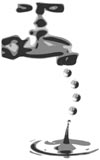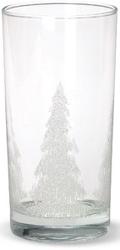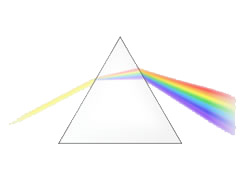Have you ever tried making music with glasses or bottles filled with water? I bet you favourite band hasn't. Experiment with your own special sounds by turning glasses of water into instruments, make some cool music and find out how it works.
Saturday, 10 December 2011
Saturday, 3 December 2011
 Make a Crystal Snowflake!
Make a Crystal Snowflake!
What you'll need:
Instructions:
- Grab a white pipe cleaner and cut it into three sections of the same size. Twist these sections together in the center so that you now have a shape that looks something like a six-sided star. Make sure the points of your shape are even by trimming them to the same length.
- Take the top of one of the pipe cleaners and attach another piece of string to it. Tie the opposite end to your small wooden rod or pencil. You will use this to hang your completed snowflake.
- Carefully fill the jar with boiling water (you might want to get an adult to help with this part).
- For each cup of water add three tablespoons of borax, adding one tablespoon at a time. Stir until the mixture is dissolved but don’t worry if some of the borax settles at the base of the jar.
- Add some of the optional blue food coloring if you'd like to give your snowflake a nice bluish tinge.
- Put the pipe cleaner snowflake into the jar so that the small wooden rod or pencil is resting on the edge of the jar and the snowflake is sitting freely in the borax solution.
- Leave the snowflake overnight and when you return in the morning you will find the snowflake covered in crystals! It makes a great decoration that you can show your friends or hang somewhere in your house.
What's happening?
Crystals are made up of molecules arranged in a repeating pattern that extends in all three dimensions. Borax is also known as sodium borate, it is usually found in the form of a white powder made up of colorless crystals that are easily dissolved in water.
When you add the borax to the boiling water you can dissolve more than you could if you were adding it to cold water, this is because warmer water molecules move around faster and are more spread apart, allowing more room for the borax crystals to dissolve.
When the solution cools, the water molecules move closer together and it can't hold as much of the borax solution. Crystals begin to form on top of each other and before you know it you have your completed crystal snow flake!
 Make Your Own Rainbow
Make Your Own Rainbow
What you'll need:
Instructions:
- Take the glass of water and paper to a part of the room with sunlight (near a window is good).
- Hold the glass of water (being careful not to spill it) above the paper and watch as sunlight passes through the glass of water, refracts (bends) and forms a rainbow of colors on your sheet of paper.
- Try holding the glass of water at different heights and angles to see if it has a different effect.
What's happening?
While you normally see a rainbow as an arc of color in the sky, they can also form in other situations. You may have seen a rainbow in a water fountain or in the mist of a waterfall and you can even make your own such as you did in this experiment.
Rainbows form in the sky when sunlight refracts (bends) as it passes through raindrops, it acts in the same way when it passes through your glass of water. The sunlight refracts, separating it into the colors red, orange, yellow, green, blue, indigo and violet.
Thursday, 1 December 2011
 Bending Water with Static
Bending Water with Static

What you'll need:
- A plastic comb (or an inflated balloon)
- A narrow stream of water from a tap
- Dry hair
Instructions:
- Turn on the water so it is falling from the tap in a narrow stream (just a few millimetres across but not droplets).
- Run the comb through your hair just as you normally would when brushing it (do this around 10 times). If you are using a balloon then rub it back and forth against your hair for a few seconds.
- Slowly move the comb or balloon towards the stream of water (without touching it) while watching closely to see what happens.
What's happening?
The static electricity you built up by combing your hair or rubbing it against the balloon attracts the stream of water, bending it towards the comb or balloon like magic!
Negatively charged particles called electrons jump from your hair to the comb as they rub together, the comb now has extra electrons and is negatively charged. The water features both positive and negatively charged particles and is neutral. Positive and negative charges are attracted to each other so when you move the negatively charged comb (or balloon) towards the stream, it attracts the water's positively charged particles and the stream bends!














